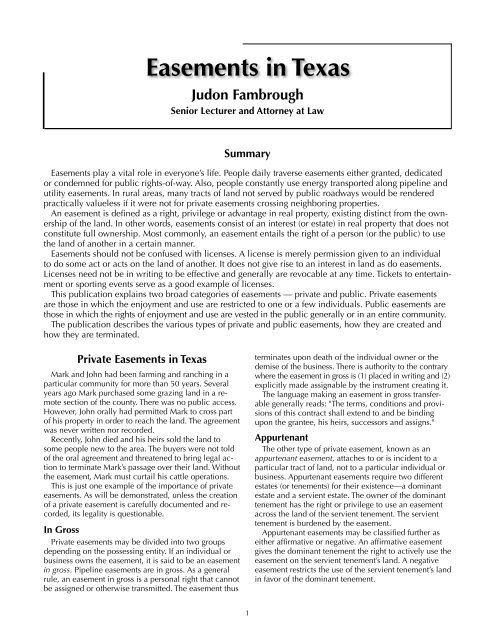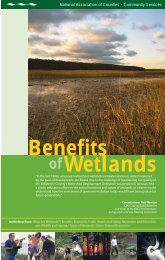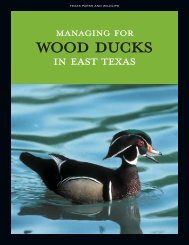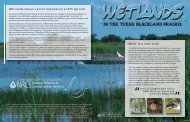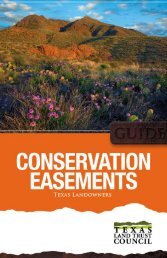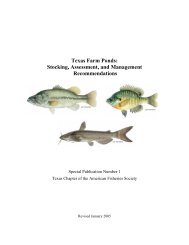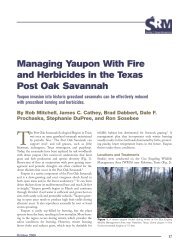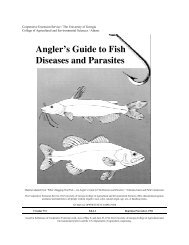<strong>Easements</strong> <strong>in</strong> <strong>Texas</strong>Judon FambroughSenior Lecturer and Attorney at LawSummary<strong>Easements</strong> play a vital role <strong>in</strong> everyone’s life. People daily traverse easements either granted, dedicatedor condemned for public rights-of-way. Also, people constantly use energy transported along pipel<strong>in</strong>e andutility easements. In rural areas, many tracts of land not served by public roadways would be renderedpractically valueless if it were not for private easements cross<strong>in</strong>g neighbor<strong>in</strong>g properties.An easement is def<strong>in</strong>ed as a right, privilege or advantage <strong>in</strong> real property, exist<strong>in</strong>g dist<strong>in</strong>ct from the ownershipof the land. In other words, easements consist of an <strong>in</strong>terest (or estate) <strong>in</strong> real property that does notconstitute full ownership. Most commonly, an easement entails the right of a person (or the public) to usethe land of another <strong>in</strong> a certa<strong>in</strong> manner.<strong>Easements</strong> should not be confused with licenses. A license is merely permission given to an <strong>in</strong>dividualto do some act or acts on the land of another. It does not give rise to an <strong>in</strong>terest <strong>in</strong> land as do easements.Licenses need not be <strong>in</strong> writ<strong>in</strong>g to be effective and generally are revocable at any time. Tickets to enterta<strong>in</strong>mentor sport<strong>in</strong>g events serve as a good example of licenses.This publication expla<strong>in</strong>s two broad categories of easements — private and public. Private easementsare those <strong>in</strong> which the enjoyment and use are restricted to one or a few <strong>in</strong>dividuals. Public easements arethose <strong>in</strong> which the rights of enjoyment and use are vested <strong>in</strong> the public generally or <strong>in</strong> an entire community.The publication describes the various types of private and public easements, how they are created andhow they are term<strong>in</strong>ated.Private <strong>Easements</strong> <strong>in</strong> <strong>Texas</strong>Mark and John had been farm<strong>in</strong>g and ranch<strong>in</strong>g <strong>in</strong> aparticular community for more than 50 years. Severalyears ago Mark purchased some graz<strong>in</strong>g land <strong>in</strong> a remotesection of the county. There was no public access.However, John orally had permitted Mark to cross partof his property <strong>in</strong> order to reach the land. The agreementwas never written nor recorded.Recently, John died and his heirs sold the land tosome people new to the area. The buyers were not toldof the oral agreement and threatened to br<strong>in</strong>g legal actionto term<strong>in</strong>ate Mark’s passage over their land. Withoutthe easement, Mark must curtail his cattle operations.This is just one example of the importance of privateeasements. As will be demonstrated, unless the creationof a private easement is carefully documented and recorded,its legality is questionable.In GrossPrivate easements may be divided <strong>in</strong>to two groupsdepend<strong>in</strong>g on the possess<strong>in</strong>g entity. If an <strong>in</strong>dividual orbus<strong>in</strong>ess owns the easement, it is said to be an easement<strong>in</strong> gross. Pipel<strong>in</strong>e easements are <strong>in</strong> gross. As a generalrule, an easement <strong>in</strong> gross is a personal right that cannotbe assigned or otherwise transmitted. The easement thusterm<strong>in</strong>ates upon death of the <strong>in</strong>dividual owner or thedemise of the bus<strong>in</strong>ess. There is authority to the contrarywhere the easement <strong>in</strong> gross is (1) placed <strong>in</strong> writ<strong>in</strong>g and (2)explicitly made assignable by the <strong>in</strong>strument creat<strong>in</strong>g it.The language mak<strong>in</strong>g an easement <strong>in</strong> gross transferablegenerally reads: "The terms, conditions and provisionsof this contract shall extend to and be b<strong>in</strong>d<strong>in</strong>gupon the grantee, his heirs, successors and assigns."AppurtenantThe other type of private easement, known as anappurtenant easement, attaches to or is <strong>in</strong>cident to aparticular tract of land, not to a particular <strong>in</strong>dividual orbus<strong>in</strong>ess. Appurtenant easements require two differentestates (or tenements) for their existence—a dom<strong>in</strong>antestate and a servient estate. The owner of the dom<strong>in</strong>anttenement has the right or privilege to use an easementacross the land of the servient tenement. The servienttenement is burdened by the easement.Appurtenant easements may be classified further aseither affirmative or negative. An affirmative easementgives the dom<strong>in</strong>ant tenement the right to actively use theeasement on the servient tenement’s land. A negativeeasement restricts the use of the servient tenement’s land<strong>in</strong> favor of the dom<strong>in</strong>ant tenement.1
An example will clarify these two types of easements.Suppose landowner "A" wants to build a dam that willback water across landowner "B’s" property. To keep "B"from su<strong>in</strong>g, "A" seeks an affirmative easement from "B"allow<strong>in</strong>g "A" to flood a portion of "B’s" land. If "A" is successful,"A’s" land will be the dom<strong>in</strong>ant tenement, and"B’s" land will be the servient tenement. "B’s" land willbe burdened by the stand<strong>in</strong>g water.Suppose further that "B" becomes dependent uponthe supply of water provided by "A’s" dam. "B" wants to<strong>in</strong>vest <strong>in</strong> some livestock but needs the assurance of apermanent source of water. Here "B" will seek a negativeeasement from A. The negative easement wouldrestrict A from destroy<strong>in</strong>g the dam or dra<strong>in</strong><strong>in</strong>g the water.These are rights "A" would have except for the negativeeasement.The only duty an easement imposes on the owner ofthe servient estate is that of a negative nature. The servientowner may not <strong>in</strong>terfere with the use and enjoymentof the dom<strong>in</strong>ant estate’s easement across the land. Anyrepairs or works necessary to effectuate the use and enjoymentof the easement must be made by the dom<strong>in</strong>antowner.Appurtenant easements are easily transferable. Aconveyance of the dom<strong>in</strong>ant tenement automatically<strong>in</strong>cludes the easement across the servient tenement’sland. A transfer of the servient estate will <strong>in</strong>clude theeasement burden<strong>in</strong>g it if the purchaser has actual orconstructive notice of the easement’s existence. If thedom<strong>in</strong>ant tenement purchases the servient tenement’sland, the easement term<strong>in</strong>ates. One cannot own aneasement across his or her property.Creation of Private <strong>Easements</strong>An easement may be created by various means. Eachhas its own dist<strong>in</strong>ct requirements. Because easementsrepresent <strong>in</strong>terests <strong>in</strong> land, they generally require somewritten, tangible evidence prescribed by Section 5.021of the <strong>Texas</strong> Property Code for their creation. The writtenrequirements may be waived where the person claim<strong>in</strong>gthe easement has (1) paid consideration for the easement<strong>in</strong> money or services, (2) began us<strong>in</strong>g the easementand (3) made valuable and permanent improvementsto the easement.The written document creat<strong>in</strong>g an easement need notbe recorded to be effective. However, to give constructivenotice to subsequent purchasers as described <strong>in</strong>Section 13.002 of the <strong>Texas</strong> Property Code, easementsnormally are recorded.An easement may be created <strong>in</strong> three ways without awritten document. They are (1) by implication, (2) by estoppeland (3) by prescription. The party claim<strong>in</strong>g suchan easement may have to resort to a judicial processknown as a declaratory judgment to claim it.<strong>Easements</strong> by ImplicationImplied easements may be created one of three ways:(1) by reservation, (2) by grant or (3) by way of necessity.Each is dist<strong>in</strong>ctive.<strong>Easements</strong> by implied reservation or grant. The creationof an implied easement by either reservation orgrant requires the prior existence and use of the easement.Furthermore, the prior use must have been apparent,permanent, cont<strong>in</strong>uous and necessary for the enjoymentof the property granted. In each implied easementcase, the court views the implied easement as merelyan oversight on the part of the grantor and grantee at thetime of the conveyance.For <strong>in</strong>stance, suppose "A" owns a 40-acre tract of landwith a public road runn<strong>in</strong>g along its southern boundary."A’s" house sits along the northern part of the 40-acretract. It is served by a private road runn<strong>in</strong>g north andsouth. A decides to sell the southern 20 acres to "B."However, A forgets to reserve a right-of-way easementacross the 20 acres to access the home.This is a classical example of when the court mostlikely would approve an implied reservation for "A."The easement must have been apparent, permanentand cont<strong>in</strong>uously used at the time of the grant. The onlyother requisite is that there are no other available accessroutes this route is necessary.An implied grant of an easement can be illustrated bythe same set of facts. Suppose "A" decided to sell thenorthern 20 acres. "A" reta<strong>in</strong>s title and possession to thesouthern 20 acres along the public roadway. If A doesnot grant an easement to "B" across the southern 20acres when title is conveyed, the courts may approve aneasement by implied grant.The implied grant would require the same elementsas the implied reservation. In other words, the easementmust be apparent, permanent, cont<strong>in</strong>uous and necessaryfor "B’s" use and enjoyment of the property.There is some case authority that holds the courts willrecognize an implied grant more readily than an impliedreservation. The rule is based on the proposition that thelaw will imply an easement <strong>in</strong> favor of the grantee morereadily than one <strong>in</strong> favor of the grantor. The propositionassumes that if the grantor <strong>in</strong>tended to reserve anyright over the property granted, he or she should haveexpressly done so <strong>in</strong> the deed. However, not all casesare uniform on this po<strong>in</strong>t.<strong>Easements</strong> by way of necessity. F<strong>in</strong>ally, an impliedeasement may arise by way of necessity. This easementdiffers primarily from the other two implied easements<strong>in</strong> that no prior existence or use of the easement isrequired. As the name implies, an easement of thisnature arises only where routes of <strong>in</strong>gress and egress arecompletely nonexistent.For an implied easement by way of necessity to arise,the follow<strong>in</strong>g three conditions must be fulfilled. First,there must have been unity of ownership of the dom<strong>in</strong>antand servient estates at the time of conveyance or atsome prior time. Second, the easement must be absolutelynecessary for the grantee to enter and leave theproperty. Third, the necessity for the easement existed atthe time of the severance of the dom<strong>in</strong>ant and servientestates.As to the issue of unity of ownership, case law requiresthat sometime <strong>in</strong> the cha<strong>in</strong> of title after the land2


